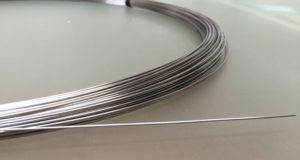- Application: For hyperelastic memory alloy mobile phone antenna, fishing hook, fishing rod, children’s toy antenna, optical spectacle frame, Bluetooth headset, ear hanger, medicine. With the development of the times, it is gradually used in women’s garment brackets, which are used as scientific research materials and frequently appear in materials laboratories of various technical colleges.
- Product characteristics: It has mechanical properties and corrosion resistance, memory function, and can restore memory shape at phase change temperature.
- Product classification: temperature memory and elastic memory.
- Advantages: Super memory, super elasticity, small size, light weight, low power, high strength, accurate control, AC or DC activation, long life, linear motion.
Various parameters of Ti-Ni alloy memory wire:
Specification: Diameter more than 0.1mm * coil (straight wire)
Standard: Q/XB1516 Q/XB1520
Brand:
TiNi-01 Phase Transition Temperature: 20-40 C
TiNi-02 Phase Transition Temperature: 45-65
TiNi-SS Phase Transition Temperature: 5-15 C
TiNi-03 Phase Transition Temperature: <5 Temperature
TiNi-YY Phase Transition Temperature: 33 +3
TiNiCU Phase Transition Temperature: As-Ms <5 C TiNiNb
Phase transition temperature: As-Ms < 150 C
Physical properties of Ti-Ni alloy memory wires:
Tensile strength: 850 MPa yield strength: 195-690 MPa elongation: 25-50%
Chemical composition: Ni: 55.4% – 56.2% C < 0.07 H < 0.005 O < 0.050 N:< 0.05
Execution Standard: ASTM-2063-01 ASTM F2063-2000 Shape Memory Alloy processing materials so-called memory metals refer to a series of “memory” metals and alloys.
After the metal is deformed, under certain external conditions, such as high pressure, high temperature, low temperature and electrification, the state before deformation can be restored to it. Memory metals are widely used and all their properties vary with temperature. From the microscopic point of view, the atoms of memory metals (metal is made up of atoms, not ions or molecules) have unique configurations in spatial structure. After changing their macro-morphology by external forces, and under certain conditions, their spatial structure may recover.

